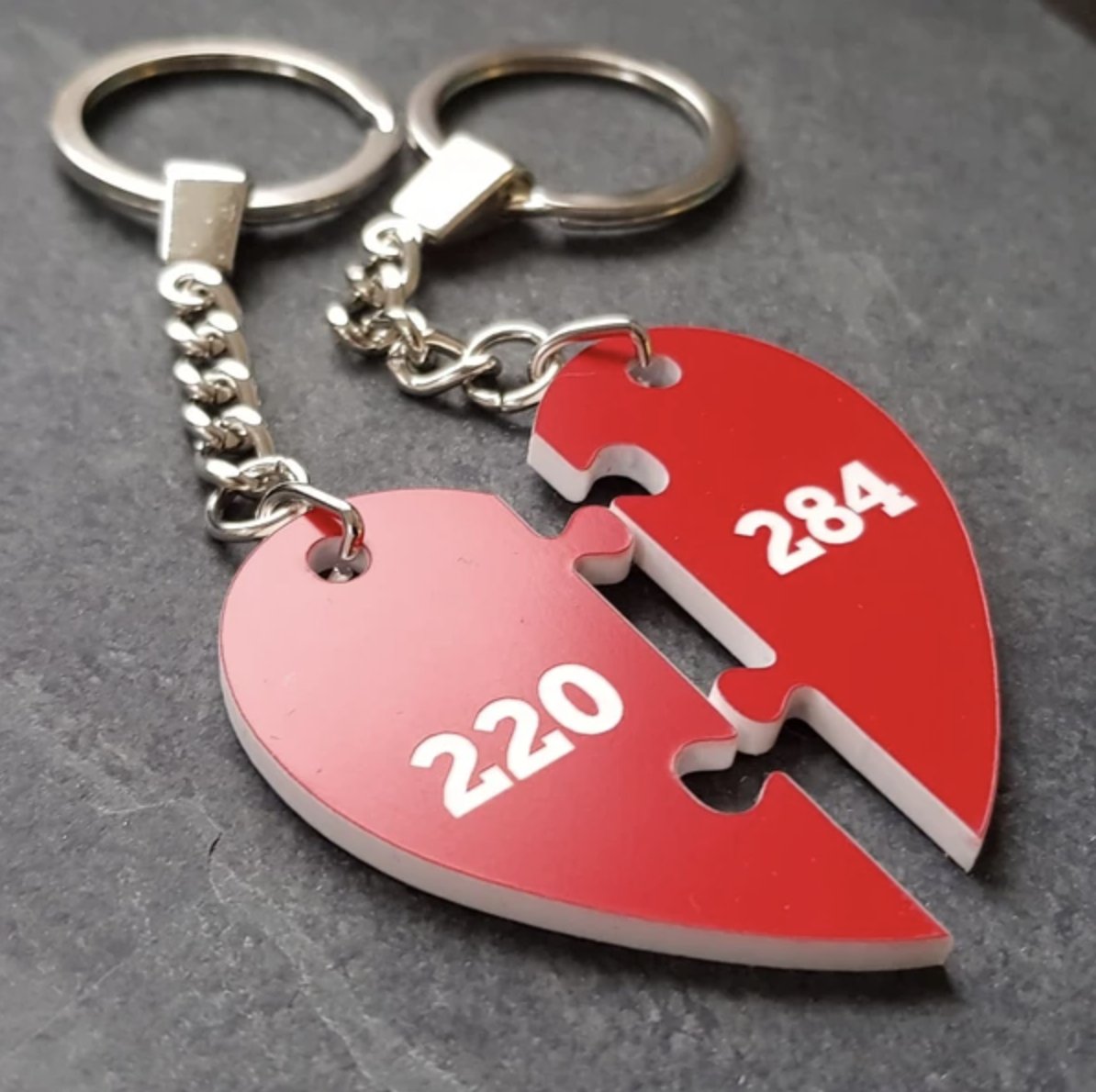Will you be the 220 to my 284?
For centuries, special numbers called amicable pairs have been associated with love and friendship. In fact, amicable pairs are often referred to as friendly numbers.
The smallest amicable pair, (220, 284), was known as early as 300 BCE.
For centuries, special numbers called amicable pairs have been associated with love and friendship. In fact, amicable pairs are often referred to as friendly numbers.
The smallest amicable pair, (220, 284), was known as early as 300 BCE.
How do two numbers comprise an amicable pair?
We say two numbers are amicable if each is the sum of proper divisors of the other.
Let’s see how this works with the smallest pair: (220, 284).
We say two numbers are amicable if each is the sum of proper divisors of the other.
Let’s see how this works with the smallest pair: (220, 284).
First, we find all numbers that divide 220 (divisors) and get the following list:
1, 2, 4, 5, 10, 11, 20, 22, 44, 55, 110, & 220
A divisor is proper if it is not equal to the number itself, so we ignore 220. So we see:
1 + 2 + 4 + 5 + 10 + 11 + 20 + 22 + 44 + 55 + 110 = 284
1, 2, 4, 5, 10, 11, 20, 22, 44, 55, 110, & 220
A divisor is proper if it is not equal to the number itself, so we ignore 220. So we see:
1 + 2 + 4 + 5 + 10 + 11 + 20 + 22 + 44 + 55 + 110 = 284
Similarly, we find all divisors of 284 and get the following list:
1, 2, 4, 71, 142, & 284
Again, we only want proper divisors and so we ignore 284. Then we see that:
1 + 2 + 4 + 71 + 142 = 220
1, 2, 4, 71, 142, & 284
Again, we only want proper divisors and so we ignore 284. Then we see that:
1 + 2 + 4 + 71 + 142 = 220
A group of followers of the mathematician Pythagoras, called the Pythagoreans, believed that amicable numbers had mystical properties, and that the way the two numbers were intertwined through the sum of their divisors suggested love and friendship.
It is even rumored that in ancient times one would carve an amicable number into a piece of fruit, and feed this to the person they loved as a sort of mathematical aphrodisiac!
The Greeks, captivated by these friendly numbers, searched for amicable pairs aside from 220 and 284, but could not find others.
For hundreds of years, the total count of amicable pairs remained at one.
For hundreds of years, the total count of amicable pairs remained at one.
In the 9th century, an Arabic mathematician named Thābit ibn Qurra discovered TWO new amicable pairs:
1)17,296 and 18,416
2)9,363,584 and 9,437,056
This increased the total count of amicable pairs to three.
He found amicable pairs using a formula now called the Qurra rule.
1)17,296 and 18,416
2)9,363,584 and 9,437,056
This increased the total count of amicable pairs to three.
He found amicable pairs using a formula now called the Qurra rule.
Qurra’s discovery did not make it back to Europe, and these two amicable pairs were “rediscovered” by Fermat in 1636 and Descartes in 1638.
It was not until 1750 that Euler discovered 58 more amicable pairs, bringing the known total count from three to sixty one!
It was not until 1750 that Euler discovered 58 more amicable pairs, bringing the known total count from three to sixty one!
How did Euler do it? Similar to Qurra, he too developed a rule for finding pairs. He described his methods in a treatise: “De Numeris Amicabilibus.”
These methods are described in a talk “Euler’s Amicable Numbers” given by William Dunham linked below:
These methods are described in a talk “Euler’s Amicable Numbers” given by William Dunham linked below:
Today, more than 1.2 billion amicable pairs have been discovered.
Serge Chernykh has discovered more than 1 billion pairs, finding over 300,000 in 2021 alone! He maintains a site that has the most comprehensive collection of friendly numbers to date.
https://sech.me/ap/
Serge Chernykh has discovered more than 1 billion pairs, finding over 300,000 in 2021 alone! He maintains a site that has the most comprehensive collection of friendly numbers to date.
https://sech.me/ap/
Why have so many searched for and studied amicable pairs? I counter with why not? Among many things, math can be used for fun and exploration.
This Valentine’s Day reflect on the beauty of recreational math! And on all days, practice good deeds and be the 220 to someone’s 284.
This Valentine’s Day reflect on the beauty of recreational math! And on all days, practice good deeds and be the 220 to someone’s 284.

 Read on Twitter
Read on Twitter






